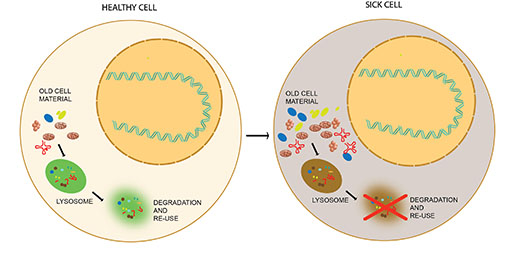Cellular recycling may help patients with lethal disease
Despite detrimental symptoms and high lethality, patients with rare diseases suffer from lack of treatment options, due to a lack of drug development investments. New basic research from BRIC, University of Copenhagen, suggests a new therapeutic strategy for patients with the deadly disease Multiple Sulphatase Deficiency (MSD). The results are published in Nature Communications.
 All our cells contain recycling plants called lysosomes. Here, old cell material and waste are degraded and then recycled or destroyed. In order to understand this recycling process, researchers at BRIC looked for regulatory molecules and found the micro-RNA molecule miR-95.
All our cells contain recycling plants called lysosomes. Here, old cell material and waste are degraded and then recycled or destroyed. In order to understand this recycling process, researchers at BRIC looked for regulatory molecules and found the micro-RNA molecule miR-95.
- Our experiments showed that miR-95 can regulate the lysosomal capacity for degradation and recycling of cellular waste products. If the process is disturbed, our cells' ability to grow and survive is reduced, says Professor Anders H. Lund, head of the research group at BRIC.
Mir-95 turns off recycling enzymes
The researchers showed that miR-95 act through regulation of a group of enzymes called sulphatases, which are important for the lysosomes' degradation ability. These are the first results to show that a micro-RNA molecule in this way can regulate cellular recycling.

The lysosomes contain enzymes that degrade cellular waste products for recycling. This is crucial to sustain a healthy cellular environment. In lysosomal storage disorders as MSD, waste degradation is reduced causing accumulation of cell-harming products. Illustration: Lisa Frankel
-If we artificially increase the amount of miR-95 in human cells, we can turn off the central molecule SUMF1 and thereby all 17 sulphatase enzymes present in the lysosomes. This results in an accumulation of toxic cellular waste products and inhibited cell growth, explains postdoc Lisa Frankel who has been leading the experiments.
New knowledge is promising for disease treatment strategies

From healthy to diseased cell. By increasing the amount of miR-95 in human cells, researchers mimic MSD where cellular waste accumulates in the cells. Photo: Lisa Frankel.
The new knowledge made the researchers look into a group of diseases called lysosomal storage disorders (LSD), where the lysosomes are incapable of optimal waste handling.
-Through inhibition of miR-95 in cells isolated from patients with one of these diseases, Multiple Sulphatase Deficiency (MSD), we could reactivate the sulphatases and thereby waste handling. This suggests a completely new strategy for treatment of MSD and likely also other LSD diseases, says Anders H. Lund.
The researchers hope that their results can be exploited to develop new treatment modalities for LSD. Even though there is a long way from their basic research results to the clinic, the concept of targeting miRNA-molecules looks to have a promising future. It has already show effective in for example treatment of hepatitis C, where a drug targeting miR-122 is currently in clinical trails.
Facts
LSD includes more than 50 different rare diseases, striking 1:5000 persons world-wide. Existing treatment options are few and expensive. LSD diseases have different pathologies, but share the problem with decreased cellular waste handling and accumulation of toxic products in the cells. Despite each of the 50 diseases are rare, they have detrimental consequences for the patients and results in damage on the body and brain and cause an early death.
Original paper
Frankel, L.B., Di Malta, C., Wen, J., Eskelinen, E.L., Ballabio, A. and Lund A.H. (2014). A non-conserved miRNA regulates lysosomal function and impacts human lysosomal storage disorders. Nature Communications.
Contact
Professor Anders H. Lund, BRIC
phone: +45 3532 5657
email: anders.lund@bric.ku.dk
Postdoc Lisa Frankel
phone: +45 3532 5813
email: lisa.frankel@bric.ku.dk
Research Coordinator Katrine Sonne-Hansen
phone: +45 3532 5648
email: katrine.sonne@bric.ku.dk
